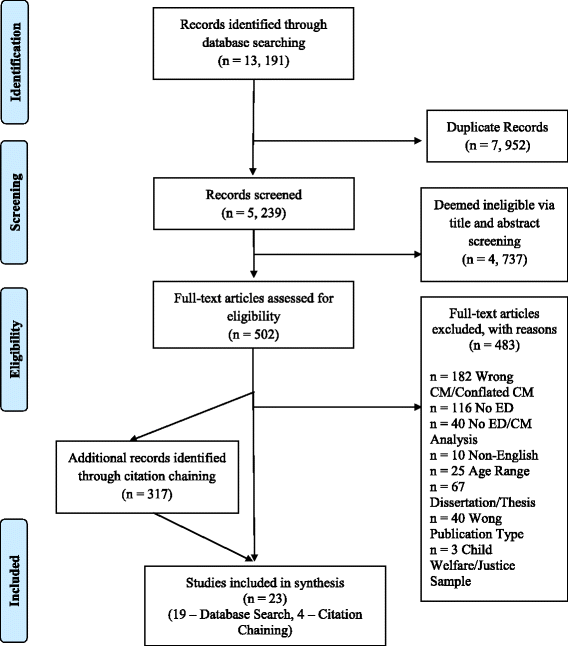Consequences of child emotional abuse, emotional neglect and exposure to intimate partner violence for eating disorders: a systematic critical review
- PMID: 28938897
- PMCID: PMC5610419
- DOI: 10.1186/s40359-017-0202-3
Consequences of child emotional abuse, emotional neglect and exposure to intimate partner violence for eating disorders: a systematic critical review
Abstract
Background: Child maltreatment and eating disorders are significant public health problems. Yet, to date, research has focused on the role of child physical and sexual abuse in eating-related pathology. This is despite the fact that globally, exposure to emotional abuse, emotional neglect and intimate partner violence are the three of the most common forms of child maltreatment. The objective of the present study is to systematically identify and critically review the literature examining the association between child emotional abuse (EA), emotional neglect (EN), and exposure to intimate partner violence (IPV) and adult eating-disordered behavior and eating disorders.
Methods: A systematic search was conducted of five electronic databases: Medline, Embase, PsycINFO, CINAHL, and ERIC up to October 2015 to identify original research studies that investigated the association between EA, EN and children's exposure to IPV, with adult eating disorders or eating-disordered behavior using a quantitative research design. Database searches were complemented with forward and backward citation chaining. Studies were critically appraised using the Quality in Prognosis Studies (QUIPS) tool.
Results: A total of 5556 publications were screened for this review resulting in twenty-three articles included in the present synthesis. These studies focused predominantly on EA and EN, with a minority examining the role of child exposure to IPV in adult eating-related pathology. Prevalence of EA and EN ranged from 21.0% to 66.0%, respectively. No prevalence information was provided in relation to child exposure to IPV. Samples included predominantly White women. The methodological quality of the available literature is generally low. Currently, the available literature precludes the possibility of determining the extent to which EA, EN or child exposure to IPV have independent explanatory influence in adult eating-related pathology above what has been identified for physical and sexual abuse.
Conclusions: While a large proportion of adults with eating disorders or eating-disordered behavior report EA, EN, or child exposure to IPV , there is a paucity of high-quality evidence about these relationships.
Keywords: Child exposure to intimate partner violence; Child maltreatment; Eating disorders; Emotional abuse; Emotional neglect.
Conflict of interest statement
Ethics approval and consent to participate
Not applicable.
Consent for publication
Not applicable.
Competing interests
The authors declare that they have no competing interests.
Publisher’s Note
Springer Nature remains neutral with regard to jurisdictional claims in published maps and institutional affiliations.
Figures
Similar articles
-
Measures for screening for intimate partner violence: a systematic review.J Psychiatr Ment Health Nurs. 2016 Apr;23(3-4):217-35. doi: 10.1111/jpm.12289. Epub 2016 Mar 31. J Psychiatr Ment Health Nurs. 2016. PMID: 27029235
-
The long-term health consequences of child physical abuse, emotional abuse, and neglect: a systematic review and meta-analysis.PLoS Med. 2012;9(11):e1001349. doi: 10.1371/journal.pmed.1001349. Epub 2012 Nov 27. PLoS Med. 2012. PMID: 23209385 Free PMC article.
-
Association between intimate partner violence and depressive symptoms across household wealth levels in women of reproductive age in Peru.Womens Health (Lond). 2025 Jan-Dec;21:17455057251351410. doi: 10.1177/17455057251351410. Epub 2025 Jul 6. Womens Health (Lond). 2025. PMID: 40618231 Free PMC article.
-
Individual and group-based parenting programmes for the treatment of physical child abuse and neglect.Cochrane Database Syst Rev. 2006 Jul 19;(3):CD005463. doi: 10.1002/14651858.CD005463.pub2. Cochrane Database Syst Rev. 2006. PMID: 16856097
-
Interventions for preventing eating disorders in children and adolescents.Cochrane Database Syst Rev. 2002;2002(2):CD002891. doi: 10.1002/14651858.CD002891. Cochrane Database Syst Rev. 2002. PMID: 12076457 Free PMC article.
Cited by
-
Adverse experiences as predictors of maladaptive and adaptive eating: Findings from EAT 2018.Appetite. 2022 Jan 1;168:105737. doi: 10.1016/j.appet.2021.105737. Epub 2021 Oct 7. Appetite. 2022. PMID: 34627979 Free PMC article.
-
Lyme Disease Misinterpreted as Child Abuse.Case Rep Orthop. 2021 Feb 1;2021:6665935. doi: 10.1155/2021/6665935. eCollection 2021. Case Rep Orthop. 2021. PMID: 33628554 Free PMC article.
-
Early maladaptive schemas mediate the relationship between severe childhood trauma and eating disorder symptoms: evidence from an exploratory study.J Eat Disord. 2024 Sep 11;12(1):138. doi: 10.1186/s40337-024-01103-y. J Eat Disord. 2024. PMID: 39261959 Free PMC article.
-
Building resilience through daily smartphone app use: results of a pilot study of the JoyPop app with social work students.Front Digit Health. 2023 Nov 20;5:1265120. doi: 10.3389/fdgth.2023.1265120. eCollection 2023. Front Digit Health. 2023. PMID: 38053917 Free PMC article.
-
[Abuse of children and adolescence].Aten Primaria. 2024 Nov;56 Suppl 1(Suppl 1):103127. doi: 10.1016/j.aprim.2024.103127. Aten Primaria. 2024. PMID: 39613358 Free PMC article. Spanish.
References
-
- Information CIfH: Use of Hospital Services for Eating Disorders in Canada. In. Ottawa, Canada: Canadian Institute for Health Information; 2014.
-
- Zhao Y, Encinosa W: An update on hospitalizations for eating disorders: 1999 to 2009. In: Healthcare cost and utilization project statistical briefs. Rockville, MD: Agency for Healthcare Research and Quality; 2009. - PubMed
Publication types
MeSH terms
LinkOut - more resources
Full Text Sources
Other Literature Sources
Medical
Research Materials


